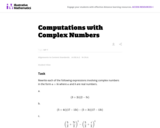
This task asks students to perform computations involving complex numbers.
- Provider:
- Illustrative Mathematics
- Date Added:
- 06/22/2022

This task asks students to perform computations involving complex numbers.

This is a computer science lesson plan created by educators in the South Sanpete School District. Students will learn about growth mindset and diverse perspectives when working together on a new project by reading Computer Decoder: Dorothy Vaughan. Students will create computational artifacts using graph paper. Activity inspired by the Only Passionate Curiosity Blog. The lesson is designed for fifth grade and includes modifications for grades 1-4.

Computer Histories is an introductory course on the history of computing that explores the questions 1) What is the history of computing? 2) What is the future of computing? and 3) What lessons can we learn from computing's past that will help guide us in determining computing's future?

This lesson plan is designed to be used as an asynchronous lesson, which can be completed either vihttps://sites.google.com/view/msparkerlearninghub/homerutally or face-to-face. It will take about 6-8, 30-minute sessions to complete. Resources for this lesson are found at https://sites.google.com/view/msparkerlearninghub/home

Computer Science Discoveries is appropriate for 6 - 10th grade students and can be taught as a semester or year long introductory course (3-5 hours per week of instruction for 9+ weeks). The course takes a wide lens on computer science by covering topics such as programming, physical computing, HTML/CSS, and data. The course inspires students as they build their own websites, apps, games, and physical computing devices.

Computer Science Principles introduces students to the foundational concepts of computer science and challenges them to explore how computing and technology can impact the world. More than a traditional introduction to programming, it is a rigorous, engaging, and approachable course that explores many of the foundational ideas of computing so all students understand how these concepts are transforming the world we live in.
This year-long course can be taught as an AP or non-AP course - no prerequisites required for students or for teachers new to computer science! In addition, our curriculum is available at no cost for anyone, anywhere to teach.

Students will recognize that computer science is so important because it can be found in almost every career. Don't wait, start learning how to code today.

This lesson centers around the How AI Works: Computer Vision video from the How AI Works video series. Watch this video first before exploring the lesson plan.
Students learn how computer vision works. They first look at optical illusions to identify the features of the drawing that their eyes noticed. Students watch a video explaining computer vision and how a computer "sees". They design an algorithm that uses a network to decide what number the seven segment display is displaying. Finally, students test their algorithm.
This lesson can be taught on its own, or as part of a 7-lesson sequence on How AI Works. Duration: 45 minutes

The purpose of this series of tasks is to build in a natural way from accessible, concrete problems involving volume to a more abstract understanding of volume. The purpose of this first task is to see the relationship between the side-lengths of a cube and its volume.

The purpose of this series of tasks is to build in a natural way from accessible, concrete problems involving volume to a more abstract understanding of volume. In this iteration, we do away with the lines that delineate individual unit cubes (which makes it more abstract) and generalize from cubes to rectangular prisms.

The purpose of this series of tasks is to build in a natural way from accessible, concrete problems involving volume to a more abstract understanding of volume. Here, we are given the volume and are asked to find the height.

The purpose of this series of tasks is to build in a natural way from accessible, concrete problems involving volume to a more abstract understanding of volume. This problem is based on ArchimedesŐ Principle that the volume of an immersed object is equivalent to the volume of the displaced water.

See how changing the concentration affects reaction rate by using this online tool

In this video segment you’ll discover how using concentric circles can help you determine how much paint is needed to cover the deck of a carousel.

"Concept Development Studies in Chemistry" is an on-line textbook for an Introductory General Chemistry course. Each module develops a central concept in Chemistry from experimental observations and inductive reasoning. This approach complements an interactive or active learning teaching approach.

This microcredential represents educators' effective instruction on conception, pregnancy, and childbirth. This is the second microcredential in the Human Sexuality stack. This stack of microcredentials fulfills one of the requirements of a pathway for endorsement. Click the More Info button to learn more.

This video clarifies the differences between habitats, ecosystems and ecological niches.

This video discusses how the concepts of structure and function can be taught using animal and plant adaptations.

Concepts of Biology is designed for the single-semester introduction to biology course for non-science majors, which for many students is their only college-level science course. As such, this course represents an important opportunity for students to develop the necessary knowledge, tools, and skills to make informed decisions as they continue with their lives. Rather than being mired down with facts and vocabulary, the typical non-science major student needs information presented in a way that is easy to read and understand. Even more importantly, the content should be meaningful. Students do much better when they understand why biology is relevant to their everyday lives. For these reasons, Concepts of Biology is grounded on an evolutionary basis and includes exciting features that highlight careers in the biological sciences and everyday applications of the concepts at hand. We also strive to show the interconnectedness of topics within this extremely broad discipline. In order to meet the needs of todays instructors and students, we maintain the overall organization and coverage found in most syllabi for this course. Instructors can customize Concepts of Biology, adapting it to the approach that works best in their classroom. Concepts of Biology also includes an innovative art program that incorporates critical thinking and clicker questions to help students understandand applykey concepts.

Concepts of Biology is designed for the introductory biology course for nonmajors taught at most two- and four-year colleges. The scope, sequence, and level of the program are designed to match typical course syllabi in the market. Concepts of Biology includes interesting applications, features a rich art program, and conveys the major themes of biology.